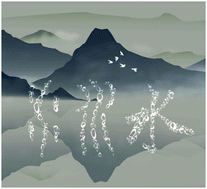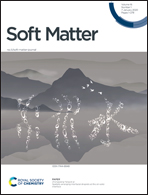Spatially arranging interfacial droplets at the oil–solid interface†
Abstract
The controlling and patterning of small droplets on a solid surface is of significant interest to understand interfacial phenomena and for practical applications. Among interfacial phenomena, the formation of interfacial droplets attracts scientists’ attention, as the mechanism of this phenomenon where water molecules can spontaneously accumulate at the hydrophobic oil/solid interface is still not fully understood. Further investigation is needed to find out specifically where the driving force comes from and how to spatially arrange the interfacial droplets. Herein, self-assembled monolayers are formed on a gold substrate, and it turns out that the hydrophobic surface with a monolayer formed from HS(CH2)11CH3 could inhibit the formation of interfacial droplets; by contrast, the hydrophilic surfaces with monolayers formed from HS(CH2)11COOH, HS(CH2)11NH3·Cl and HS(CH2)11OH, all promote water accumulation. It suggests that the hydrogen bonding between the surface and water proves to be critical in inducing interfacial droplet formation but this has been neglected in past studies. Taking advantage of microcontact printing, the surface chemistry can be controlled at the micron scale and allows spatial arrangement of interfacial droplets at specific regions. This work moves a further step in understanding the mechanism of interfacial droplet formation, and can be potentially exploited for the collection of water and fabrication of microtemplates.



 Please wait while we load your content...
Please wait while we load your content...